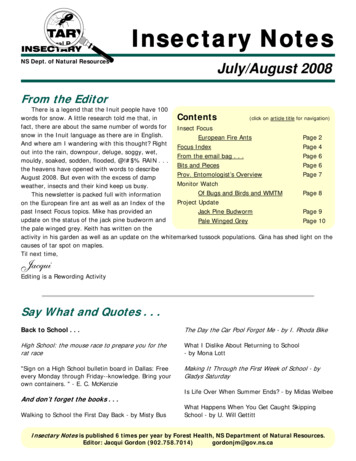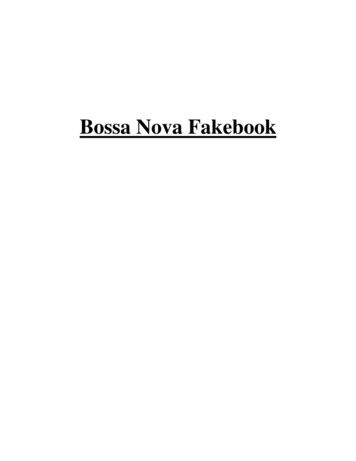
Transcription
Insectary NotesNS Dept. of Natural ResourcesJuly/August 2008From the EditorThere is a legend that the Inuit people have 100Contents(click on article title for navigation)words for snow. A little research told me that, infact, there are about the same number of words forInsect Focussnow in the Inuit language as there are in English.Page 2European Fire AntsAnd where am I wandering with this thought? RightPage 4Focus Indexout into the rain, downpour, deluge, soggy, wet,Page 6From the email bag . . .mouldy, soaked, sodden, flooded, @!# % RAIN . . .Page 6Bits and Piecesthe heavens have opened with words to describePage 7Prov. Entomologist’s OverviewAugust 2008. But even with the excess of dampMonitor Watchweather, insects and their kind keep us busy.Page 8Of Bugs and Birds and WMTMThis newsletter is packed full with informationProject Updateon the European fire ant as well as an Index of thepast Insect Focus topics. Mike has provided anPage 9Jack Pine Budwormupdate on the status of the jack pine budworm andPage 10Pale Winged Greythe pale winged grey. Keith has written on theactivity in his garden as well as an update on the whitemarked tussock populations. Gina has shed light on thecauses of tar spot on maples.Til next time,JacquiEditing is a Rewording ActivitySay What and Quotes . . .Back to School . . .The Day the Car Pool Forgot Me - by I. Rhoda BikeHigh School: the mouse race to prepare you for therat raceWhat I Dislike About Returning to School- by Mona Lott"Sign on a High School bulletin board in Dallas: Freeevery Monday through Friday--knowledge. Bring yourown containers. " - E. C. McKenzieMaking It Through the First Week of School - byGladys SaturdayAnd don’t forget the books . . .Walking to School the First Day Back - by Misty BusIs Life Over When Summer Ends? - by Midas WelbeeWhat Happens When You Get Caught SkippingSchool - by U. Will GettittInsectary Notes is published 6 times per year by Forest Health, NS Department of Natural Resources.Editor: Jacqui Gordon (902.758.7014)gordonjm@gov.ns.ca
2Insectary Notes July/ August 2008Insect FocusBack to page 1Jacqui GordonSad to say, insects rarely make the news in a good way . . . and news of the European Fire Ant and itsimpact on homeowners in Pictou and Halifax Counties is definitely not a good news story. Although it’s not aforest pest and we are not the lead agency in developing a management plan, we wanted to provide ourreaders with current information on this insect and who to contact if you have a problem with European fireants. So, here we go . . .European Fire Ant, Myrmica rubra(also known as European Red Ant)It’s important to note that these ants are only distantly related to the “true” fire ants (Solenopsis species)found in the southern U.S. and Latin America.Why are they a problem?These ants aggressively defend their territory.They will readily sting humans and animals thatventure into their foraging area. Although reaction tothe sting varies from one individual to another, thegeneral reaction is a burning sensation and aninflamed area at the site of the sting. Homeowners ininfested areas have reported that they are unableto use their yards because of the fire ant attacks.Also, European fire ants may displace our nativespecies of ants.To date, populations of the European Fire Ant areknown in the Summit Street and Jubilee Road area ofpeninsula Halifax and in Spryfield, Lower Sackville,Abercrombie, and Stellarton.Where did they come from?The European fire ant is native to cold regions of Europe and Asia. It was first discovered inNorth America in Maine in the early half of the 20th century. It is thought that the antsarrived in containerized plant material shipped from Europe.Identifying European fire antsWhere they live and how they spreadEuropean fire ants are small (only about 5 mm),red ants. The queen is a little larger. They have aconstricted "waist" that has two segments; mostnative species have only one. There are twobackward pointing spines on the middle bodysection, visible with a magnifying glass.European fire ants build nests in soil under rocks,wood or other debris. These nests are NOT large soilmounds. The number of nests is usually veryabundant, with 10-12 nests in a 10-ft x 10 ft area.They are capable of inflicting a painful, burningsting.It appears the ants spread two ways. One way isby "colony budding" into adjacent areas where agroup of ants, including the queen, moves from theoriginal colony and establishes a new nest nearby.They are also spread by human transport of nestsfrom infested areas (soil, decaying logs, pottedplants, etc.)
3Insectary Notes July/ August 2008Derailing our train of thought . . .Back to page 1When one of the native species of ants is a nuisance on your property, the shortterm control method is to apply some type of insecticide that the worker ants takeback to the queen. This usually works well because there is only one queen.The long term solution to a problem with native ant species is to make your property less attractive to the antsby amending the soil with organic matter.But, here’s where the train goes off the tracks . . .European fire ant colonies have more than one queen. In England, colonies were found with an average of15 queens per colony and a maximum of 670 queens. Multiple queens will make it much more difficult todestroy the colony by killing the queen. Also these ants like moist humid conditions and don’t seem to bebothered by organic material.Management1.2.3.Make sure you don’t bring them onto your property. Avoid transportingmaterials (soil, mulch, plants, decaying logs, etc.) unless you are certain itis free of fire ants.Remove preferred nesting sites, boards, logs, rocks . . . anything thatmaintains a moist environment.Boric acid and diatomaceous earth are two of the registered pest controlproducts that can be used. These products are most effective when everyone in the neighbourhooduses them consistently.Who to contact for more informationStephen King, ManagerSustainable Environment Management OfficeInfrastructure and Asset Management, HRMPhone: (902) 490-6188E-mail: kings@halifax.caLise CharbonneauPesticide Program CoordinatorClean Nova ScotiaPhone: (902) 420-6593E-mail: lcharb@clean.ns.caReferencesGroden, E., Drummond, F., and Berg Stack, L. 2004. European Fire Ant: A New Invasive Insect in Maine.University of Maine Cooperative Extension, Bulletin s/2550.htmEuropean Fire Ant Information Bulletin. Clean Nova Scotia.http://www.clean.ns.ca/default.asp?mn 1.274.538Groden, E., Drummond, F.A., Garnas, J. and Franceour, A. 2005. Distribution of an Invasive Ant, Myrmicarubra (Hymenoptera: formicidae), in Maine. J. Econ. Entomol. 98(6):1774-1784.
4Insectary Notes July/ August 2008Focus Index . . . . . . . . . . . . . . . . . . . July 1993-July 2008Another year gone by and it’s time for the annual index(Use underlined issue dates for navigation.)Ages of Trees . . . . . . . . . . . . . . . . . . . . April 2000Alder Flea Beetle . . . . . . . . . . . . . . . July/Aug 2004American Dog Tick . . . . . April 1999, May/Apr 2002Ants in Lawns . . . . . . . . . . . . . . . . . . . . . July 1998Asian Longhorn Beetle . . . . . . . Aug 1998, July 1999Asian Gypsy Moth . . . . . . . . . . . . . . . . . . Nov 1993Bacillus thuringiensis . . . . . . . . . . . . . . . . May 1996Bagworm Moths . . . . . . . . . . . . . . . . . . . July 1994Balsam Fir Cytospora Canker . . . . July/August 2006Balsam Fir Sawfly . . . . . . . . . . . . . . . . . Sept 1998Balsam Gall Midge . . . . . . . May 1999, Mar/Apr 2008Balsam Shootboring Sawfly . . . . . July/August 2006Balsam Twig Aphid . . . . . . . . . . . . . . . . June 1999Balsam Woolly Adelgid. . . . . . . . . . . . . . . . . . . . . Apr 1998, Jan/Feb 2001Balsam Fir Decline . . . . . . . . . . . . . . . . . . Nov 1999Bed Bug . . . . . . . . . . . . . . . . . . . . . . . . . May 1998Beech Bark Disease . . . . . . . . . . . . . . . . . Dec 1999Bees- Colony Collapse Disorder . . . . . May/Jun 2007Biocontrol of Purple Loosestrife. . . . . . . . . . . . . . . . . . . . . . . . Feb 1997, Mar 1997Biting Insects . . . . . . . . . June 1995,May/June 2000Black-legged Tick . . . . . . . . . . . . . . July/Aug 2002Blackheaded Budworm. . . . . . . . . . . . . . . . . . . . . Oct 1997, Sept/Oct 2004Blackheaded Budworm in NS . . . . . . May/June 2005Black Vine Weevil . . . . . . . . . . . . . . . Jan/Feb 2001Blow Flies . . . . . . . . . . . . . . . . . . . . . . . . Aug 1999Brown Spruce Longhorn Beetle . . . . . . . . . July 2000Browntail Moth . . . . . . . . . . . . . . . . . . . . Jan 1999Bruce Spanworm . . . . . . . . . . . . . . . . . . . Oct 1993Bug Zappers Exposed . . . . . . . . . . July 96, June 98Carpenter Ants . . . . . . . . . . . . . . . . . . . . Oct 1994Carpet Beetle . . . . . . . . . . . . . . . . . May/June 2003Chinch Bugs . . . . . . . . . . . . . . . . . . . . . . July 1999Cluster Flies . . . . . . . . . . . . . . . . . . . . . . Dec 1993Colony Collapse Disorder . . . . . . . . . May/Jun 2007Cytospora Canker . . . . . . . . . . . . July/August 2006Deathwatch Beetles . . . . . . . . . . . . . . . . . Jan 1994Deer Tick . . . . . . . . . . . . . . . . . . . . July/Aug 2002of Focus articles.Back to page 1Drugstore Beetles . . . . . . . . . . . . . . . . . . Feb 1999Due Diligence . . . . . . . . . . . . . . . . . . . . . Feb 1996Dust Mites . . . . . . . . . . . . . . . . . . . . Jan/Feb 2007Earwigs . . . . . . . . . . . . . . . . . . . . . . . . April 1995Eastern Blackheaded Budworm. . . . . . . . . . . . . . . . . . . . . Oct 1997, Sept/Oct 2004Eastern Dwarf Mistletoe . . . . . . . . . . . . . Sept 1994Eastern Spruce Beetle . . . . . . . . . . . . . . . July 1993Eastern Tent Caterpillar . . . . . . . . . . . . . . May 1994Emerald Ash Borer . . . . . . . . . . . . . . . Jan/Feb 2003European Fire Ant . . . . . . . . . . . . . . . Jul/Aug 2008European Marsh Crane Fly. . . . . . . . . . . . . . . . . . . June 1996, May/June 2002European Pine Shoot Moth . . . . . . . . . . . Sept 1996European Spruce Bark Beetle . . . . . . . . . Sept 1996Fall Cankerworm . . . . . . . . . . . . . . . . . . . Oct 1993False Powderpost Beetles . . . . . . . . . . . . . Jan 1994Fleas . . . . . . . . . . . . . . . . . . . Feb 1994, May 1998Forest Insect & Disease Survey . . . . . . . . . May 1999Forest Tent Caterpillar . . . . . . . . . . . . . . . May 1994Fruit Flies. . . . . Oct/Nov 98, Aug 99, Sept/Oct 05, July/Aug 06Fungus Midge . . . . . . . . . . . . . . . . . . . . . Dec 2000Giant Garden Slug . . . . . . . . . . . . . . . . . . Oct 1996Giant Water Bug . . . . . . . . . . . . . . . . . . June 1998Gouty Oak Gall . . . . . . . . . . . . . . . . May/June 2001Great Grey Slug . . . . . . . . . . . . . . . . . . . . Oct 1996Greenstriped Mapleworm . . . . . . . . . . . . . July 1995Ground Beetles . . . . . . . . . . . . . . . . May/June 2001Gypsy Moth . . . . . . . . . . . . . . . . . . . . . . June 1994Gypsy Moth Biocontrol . . . . . . . . . . . . . . . Jan 1997Gypsy Moth in NS . . . . . . . . . . . . . . . . . . Mar 1995Hairy Chinch Bug . . . . . . . . . . . . . . . . . . . July 1999Hardwood Discolouration . . . . . . . . . . . . . Aug 1999Harvestmen . . . . . . . . . . . . . . . . July /August 2006Hemlock Borer . . . . . . . . . . . . . . . . May/Jun 2004Hemlock Looper. . . . . . . . . . . . . Aug 1993, Nov 1994, Sept/Oct 2002Hylobius Weevil . . . . . . . . . . . . . . . . . . . April 1997Hypoxylon Canker of Poplar . . . . . . . . Mar/Apr 2003
5Insectary Notes July/ August 2008Ice Damage . . . . . . . . . . . . . . . . . . . . March 1998Indian Meal Moth . . . . Mar/Apr 2004, Jan/Feb 2008Insects as Food . . . . . . . . . . . . . . . . . . . . Jan 1996Jack-O-Lantern Fungi . . . . . . . . . . . . . . . . May 1995Jack Pine Budworm . . . . . . . . . . . March/April 2006Ladybird Beetles . . . . Sept/Oct 2001, Sept/Oct 2006Ladybugs . . . . . . . . . . . . . . . . . . . . Sept/Oct 2001Larder Beetle . . . . . . . . . . . . . . . . . . . . . Jan 1995Leatherjackets . . . . . . . . June 1996, May/June 2002Leucostoma Canker . . . . . . . . . . . July/August 2006Lice . . . . . . . . . . . . . . . . . Oct 1994, July/Aug 2001Longhorned Beetles . . . . . . . . . Jan 1994, Aug 2000Maggots Nurse Wounds . . . . . . . . . . . . . . Feb 1996Millipedes . . . . . . . . . . . . . . . . . . . . . . . . Oct 1999Mimic . . . . . . . . . . . . . . . . . . . . . . . . . . . Dec 1994Moisture Stress . . . . . . . . . . . . . . . . . . . . May 1998Mosquito Magnetism . . . . . . . . . . . . . . . . July 1997Mosquitoes . . . . . . . . . . . . . . . . . . . May/June 2000Moth Flies . . . . . . . . . . . . . . . . . . . . . . . . Dec 2000No-see-ums . . . . . . . . . . . . . . . . July/August 2002Pale Winged Grey . . . . . . . . . . . . . . . Jan/Feb 2004Pavement Ants . . . . . . . . . . . . . . . . July/Aug 2005People Pressure Diseases . . . . . . . . Aug 96, Nov 96Pheromones and Allomones . . . . . . . Sept/Oct 2005Pine Shoot Beetle . . . . . . . . . . . . . . . . March 1999Pine Spittlebug . . . . . . . . . . . . . . . . . . . . July 1996Pitcher Plant . . . . . . . . . . . . . . . . . . . . . June 1994Plantwatch . . . . . . . . . . . . . . . . . . . . . March 2000Pseudoscorpians . . . . . . . . . . . . . . . . . . April 1996Rosy Maple Moth . . . . . . . . . . . . . . . . . . . July 1995Salt Damage . . . . . . . . . . . . . . . . . . . Mar/Apr 2001Satin Moth . . . . . . . . . . . . . . . . . . . . . . June 1997Sawflies on Conifers . . . . . . . . . . . . . . . . July 1996Seedling Debarking Weevil . . . . . . . . . . . April 1997Silverfish . . . . . . . . . . . . . . . . . . . . . . . . April 1999Snow Fleas. . . . . . . . . . . . March 1994, Feb 1998, Jan/Feb 2002Sowbugs . . . . . . . . . . . . . . . . . Nov 1995, Dec 1999Spiders . . . . . . . . . . . . . . . . . . . . . . Sept/Oct 1995Springtails . . . . . . . . . . . March 1994, Jan/Feb 2002Springtime & Wildfire . . . . . . . . . . . . . . March
From the email bag . . . Page 6 Bits and Pieces Page 6 Prov. Entomologist’s Overview Page 7 Monitor Watch Of Bugs and Birds and WMTM Page 8 Project Update Jack Pine Budworm Page 9 Pale Winged Grey Page 10 Insectary Notes NS Dept. of Natural Resources From the Editor There is a legend that the Inuit people have 100 words for snow. A little .











